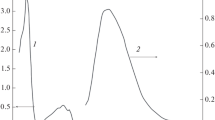Abstract
The fluorescence and triplet state quenching of 7-amino-1,3-naphthalenesulfonic acid by paramagnetic metal ions have been investigated in an aqueous medium. The basic mechanism of the fluorescence quenching involves the static and dynamic electron transfer to the paramagnetic cation. The induced S1→T1 intersystem crossing at fluorescence quenching of the fluorophore by Cu2+ cation has been found. There is a correlation between triplet state quenching rate constants and values of the efficient paramagnetic susceptibility and spin of the cations. The rate constants for the quenching pathways have been calculated.





Similar content being viewed by others
References
Lakowicz JR (1983) Principles of fluorescence spectroscopy. Plenum, New York
McClure DS (1949) Triplet-singlet transitions in organic molecules. Lifetime measurements of the triplet state. J Chem Phys 17:905
Kasha M (1952) Collisional perturbation of spin-orbital coupling and the mechanism of fluorescence quenching. A visual demonstration of the perturbation. J Chem Phys 20:71
McGlynn SP, Padhye MR, Kasha M (1955) Lowest triplet levels of the polyacenes. J Chem Phys 23:593
McGlynn SP, Azumi T, Kasha M (1964) The external heavy-atom spin orbital coupling effect. V. Absorption studies of triplet states. J Phys Chem 40:507
Föll RE, Kramer HE, Steiner UE (1990) Role of charge-transfer and spin-orbit coupling in fluorescence quenching. A case study with oxonine and substituted benzenes. J Phys Chem 94:2476
Wierzchaczewski M, Sidorowicz A, Lukowiak E, Strek W, Gawryszewska P (1995) J Appl Spectrosc 62(5):221–224
Tobita S, Arakawa M, Tanaka I (1984) Electronic relaxation processes of rare-earth chelates of benzoyltrifluoroacetone. J Phys Chem 88:2697–2702
Tobita S, Arakawa M, Tanaka I (1985) The paramagnetic metal effect on the ligand localized S1→T1 intersystem crossing in the rare-earth-metal complexes with methyl salicylate. J Phys Chem 89:5649–5654
Guldi DM, Mody TD, Gerasimchuk NN, Magda D, Sessler JL (2000) Influence of large metal cations on the photophysical properties of texaphyrin, a rigid aromatic chromophore. J Am Chem Soc 122:8289–8298
Chang JH, Kim HJ, Park JH, Shin Y-K, Chung Y (1999) Bull Korean Chem Soc 20(7):796–800
Takashima H, Kawahara H, Kitano M, Shibata S, Murakami H, Tsukahara K (2008) Metal ion-dependent fluorescent dynamics of photoexcited zinc-porphyrin and zinc-myoglobin modified with ethylenediaminetetraacetic acid. J Phys Chem B 112:15493–15502
Ricci RW, Kilichowski KB (1974) Fluorescence quenching of the indole ring system by lanthanide ions. J Phys Chem 78(19):1953–1956
Wierzchaczewski M, Sidorowicz A, Lukowiak E, Strek W, Gawryszewska P (1995) The effect of Gd3+ ions on luminescence of OPA-Gly. J Appl Spectrosc 62(5):221–224
Nakamura T, Kira A, Imamura M (1982) Enhancement of the intersystem crossing of pyrene by metal ions in sodium dodecyl sulfate micelle solutions. J Phys Chem 86:3359–3363
Chrysochoos J, Beyene K (1999) Oxidative fluorescence quenching of zinc tetraphenylporphyrin (ZnTPP) by trivalent lanthanide ions in several solvents: Role of lanthanide-induced singlet-triplet crossing. J Fluoresc 81:209–218
Melhuish WH (1961) Quantum efficiencies of fluorescence of organic substances—effect of solvent and concentration of fluorescent solute. J Phys Chem 65(2):229–235
Glebov AN, Budanov AR (1997) Soros Educational J 7:44–51 in Russian
Lur’e YY (1989) Handbook of analytical chemistry. Khimia, Moscow (in Russian)
Author information
Authors and Affiliations
Corresponding author
Rights and permissions
About this article
Cite this article
Volchkov, V.V., Ivanov, V.L. & Uzhinov, B.M. Induced Intersystem Crossing at the Fluorescence Quenching of Laser Dye 7-Amino-1,3-Naphthalenedisulfonic Acid by Paramagnetic Metal Ions. J Fluoresc 20, 299–303 (2010). https://doi.org/10.1007/s10895-009-0555-y
Received:
Accepted:
Published:
Issue Date:
DOI: https://doi.org/10.1007/s10895-009-0555-y




